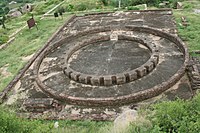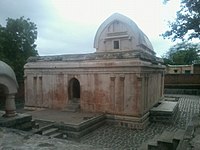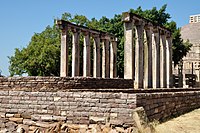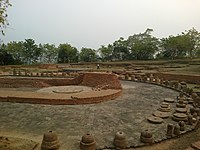Chaitya



A chaitya, chaitya hall, chaitya-griha, (Sanskrit:Caitya; Pāli: Cetiya) refers to a shrine, sanctuary, temple or prayer hall in Indian religions.[1][2] The term is most common in Buddhism, where it refers to a space with a stupa and a rounded apse at the end opposite the entrance, and a high roof with a rounded profile.[3] Strictly speaking, the chaitya is the stupa itself,[4] and the Indian buildings are chaitya halls, but this distinction is often not observed. Outside India, the term is used by Buddhists for local styles of small stupa-like monuments in Nepal, Cambodia, Indonesia and elsewhere. In Thailand a stupa, not a stupa hall, is called a chedi.[5] In the historical texts of Jainism and Hinduism, including those relating to architecture, chaitya refers to a temple, sanctuary or any sacred monument.[6][7][8]
Most early examples of chaitya that survive are Indian rock-cut architecture. Scholars agree that the standard form follows a tradition of free-standing halls made of wood and other plant materials, none of which has survived. The curving ribbed ceilings imitate timber construction. In the earlier examples, timber was used decoratively, with wooden ribs added to stone roofs. At the Bhaja Caves and the "Great Chaitya" of the Karla Caves, the original timber ribs survive; elsewhere marks on the ceiling show where they once were. Later, these ribs were rock-cut. Often, elements in wood, such as screens, porches, and balconies, were added to stone structures. The surviving examples are similar in their broad layout, though the design evolved over the centuries.[9]
The halls are high and long, but rather narrow. At the far end stands the stupa, which is the focus of devotion.
Chaityas appear at the same sites like the
Etymology
"Caitya", from a root cita or ci meaning "heaped-up", is a Sanskrit term for a mound or pedestal or "funeral pile".[1][13] It is a sacred construction of some sort, and has acquired different more specific meanings in different regions, including "caityavṛkṣa" for a sacred tree.[14]
According to K.L. Chanchreek, in early Jain literature, caitya mean ayatanas or temples where monks stayed. It also meant where the Jain idol was placed in a temple, but broadly it was a symbolism for any temple.[6][15] In some texts, these are referred to as arhat-caitya or jina-caitya, meaning shrines for an Arhat or Jina.[16] Major ancient Jaina archaeological sites such as the Kankali Tila near Mathura show Caitya-tree, Caitya-stupa, Caitya arches with Mahendra-dvajas and meditating Tirthankaras.[15]
The word caitya appears in the Vedic literature of Hinduism. In early Buddhist and Hindu literature, a caitya is any 'piled up monument' or 'sacred tree' under which to meet or meditate.[17][18][8] Jan Gonda and other scholars state the meaning of caitya in Hindu texts varies with context and has the general meaning of any "holy place, place of worship", a "memorial", or as signifying any "sanctuary" for human beings, particularly in the Grhya sutras.[1][17][7] According to Robert E. Buswell and Donald S. Lopez, both professors of Buddhist Studies, the term caitya in Sanskrit connotes a "tumulus, sanctuary or shrine", both in Buddhist and non-Buddhist contexts.[2]
The "chaitya arch" as a decorative motif
The "chaitya arch", gavaksha (Sanscrit gavākṣa), or chandrashala around the large window above the entrance frequently appears repeated as a small motif in decoration, and evolved versions continue into Hindu and Jain decoration, long after actual chaitya halls had ceased to be built by Buddhists. In these cases it can become an elaborate frame, spreading rather wide, around a circular or semi-circular medallion, which may contain a sculpture of a figure or head. An earlier stage is shown here in the entrance to Cave 19 at the Ajanta Caves (c. 475–500), where four horizontal zones of the decoration use repeated "chaitya arch" motifs on an otherwise plain band (two on the projecting porch, and two above). There is a head inside each arch.[19]
Development of the chaitya
Early Chaitya halls are known from the 3rd century BCE. They generally followed an
Rock-cut chaitya halls

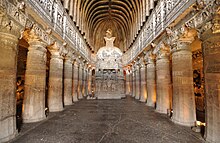
The earliest surviving spaces comparable to the chaitya hall date to the 3rd century BCE. These are the rock-cut
Early chaityas enshrined a stupa with space for congregational worship by the monks. This reflected one of the early differences between early Buddhism and Hinduism, with Buddhism favoring congregational worship in contrast to Hinduism's individual approach. Early chaitya grhas were cut into living rock as caves. These served as a symbol and sites of a sangha congregational life (uposatha).[22][23]
The earliest rock-cut chaityas, similar to free-standing ones, consisted of an inner circular chamber with pillars to create a circular path around the stupa and an outer rectangular hall for the congregation of the devotees. Over the course of time, the wall separating the stupa from the hall was removed to create an apsidal hall with a colonnade around the nave and the stupa.[24]
The chaitya at
In Bhaja, as in other chaityas, the entrance acted as the demarcation between the sacred and the profane. The stupa inside the hall was now completely removed from the sight of anyone outside. In this context, in the first century CE, the earlier veneration of the stupa changed to the veneration of an image of
The most important of rock-cut complexes are the
-
Rock-cut hall, Sudama, Barabar Caves, dedicated in 257 BCE by Ashoka.
-
Rock-cut circular Chaitya hall with pillars, Tulja Caves, 1st century BCE
-
Chaitya arch around the window, and repeated as a gavaksha motif with railings, Cave 9, Ajanta.
-
The window at the chaitya Cave 10,Ellora, c. 650
-
Timber ribs on the roof at the Karla Caves; the umbrella over the stupa is also wood
-
Decorative chaitya arches and lattice railings, Bedse Caves, 1st century BCE
-
Stupa inside Cave 10,Ellora, the last chaitya hall built, the Buddha image now dominating the stupa.
Freestanding chaitya halls

A number of freestanding constructed chaitya halls built in durable materials (stone or brick) have survived, the earliest from around the same time as the earliest rock-cut caves. There are also some ruins and groundworks, such as a circular type from the 3rd century BCE, the Bairat Temple, in which a central stupa was surrounded by 27 octagonal wooden pillars, and then enclosed in a circular brick wall, forming a circular procession path around the stupa.[20] Other significant remains of the bases of structural chaityas including those at Guntupalle, with many small round bases, and Lalitgiri.[27]
An
Later, the platform was enlarged to 41.76x27.74 metres and re-used to erect a pillared hall with fifty columns (5x10) of which stumps remain. Some of these pillars have inscriptions of the 2nd century BCE.The base and reconstructed columns on three sides of Temple 18 at Sanchi were presumably completed by wood and thatch; this dates from the 5th century CE, perhaps rebuilt on earlier foundations. This stands next to Temple 17, a small flat-roofed temple with a lower mandapa at the front, of the basic type that came to dominate both Buddhist and Hindu temples in the future. The two types were used in the Gupta Empire by both religions.[32]
The
Another Hindu temple which was converted from a Buddhist chaityagriha structure is the very small Kapoteswara temple at
-
Remains of the circular Chaitya hall in Bairat Temple, 3rd century BCE.
-
Relief of a circular chaitya hall, Bharhut, circa 100 BCE.
-
Reconstruction of Sanchi Temple 40 (3rd century BCE).
-
Trivikrama Temple with its chaitya arch.
-
The ancient Buddhist chaitya house at Ter.
-
Remains of the chaitya hall inChejarla Kapoteswara temple.
-
Sanchi, Temple 18, from the apse end. Partly reconstructed.
-
Conjectural reconstruction of Temple 18 by Percy Brown (now dated earlier)
End of the chaitya hall

Apparently the last rock-cut chaitya hall to be constructed was Cave 10 at
The last stage of the freestanding chaitya hall temple may be exemplified by the Durga temple, Aihole, of the 7th or 8th century. This is apsidal, with rounded ends at the sanctuary end to a total of three layers: the enclosure to the sanctuary, a wall beyond this, and a pteroma or ambulatory as an open loggia with pillars running all round the building. This was the main space for parikrama or circumambulation. Above the round-ended sanctuary, now a room with a doorway, rises a shikara tower, relatively small by later standards, and the mandapa has a flat roof.[37] How long construction of chaitya halls in plant materials continued in villages is not known.
Parallels
- Toda huts

The broad resemblance between chaityas and the traditional huts still made by the
- Lycian tombs
The similarity of the 4th century BCE
Early on,
The Lycian tombs, dated to the 4th century BCE, are either free-standing or rock-cut barrel-vaulted sarcophagi, placed on a high base, with architectural features carved in stone to imitate wooden structures. There are numerous rock-cut equivalents to the free-standing structures. One of the free-standing tombs, the tomb of Payava, a Lykian aristocrat from Xanthos, and dated to 375-360 BCE, is visible at the British Museum. Both Greek and Persian influences can be seen in the reliefs sculpted on the sarcophagus.[45] The structural similarities with Indian Chaityas, down to many architectural details such as the "same pointed form of roof, with a ridge", are further developed in The cave temples of India.[46] Fergusson went on to suggest an "Indian connection", and some form of cultural transfer across the Achaemenid Empire.[47] Overall, the ancient transfer of Lycian designs for rock-cut monuments to India is considered as "quite probable".[40]
Nepal

In
Cambodia
In classical Cambodian art chaityas are boundary markers for sacred sites, generally made in sets of four, placed on the site boundary at the four cardinal directions. They generally take a pillar-like form, often topped with a stupa, and are carved on the body.[50]
Gallery
-
Cambodian sanctuary marker chaitya,Khleangstyle, c. 975–1010
See also
Notes
- ^ ISBN 978-0-521-58280-3.
- ^ ISBN 978-1-4008-4805-8.
- ^ Michell, 66–67; Harle, 48
- ^ Harle (1994), 48
- ^ "Chedi". 17 January 2023.
- ^ ISBN 978-81-88658-51-0.
- ^ ISBN 90-04-06210-6.
- ^ ISBN 978-81-208-0223-0.
- ^ Michell, 66, 374; Harle, 48, 493; Hardy, 39
- ^ Michell, 65–66
- ^ Michell, 67
- ^ Harle (1994), 26, 48
- ^ Harle, 26, 48
- ^ ISBN 978-81-7017-208-6.
- ^ Mohan Lal Mehta (1969). Jaina Culture. P.V. Research Institute. p. 125.
- ^ ISBN 90-04-07590-9.
- ^ Caitya, Encyclopaedia Britannica
- ^ Michell, 69, 342; Harle, 48, 119
- ^ ISBN 9780199088140.
- ISBN 978-90-04-18525-8.
- ISBN 978-0-300-06217-5.
- ISBN 978-0-19-936238-7.
- ^ ISBN 0-500-69001-4.
- ^ ASI, "Bhaja Caves" Archived 2013-08-10 at the Wayback Machine; Michell, 352
- ^ Quoted in Hardy, 18
- ^ Group of Buddhist Monuments, Guntupalli. ASI Archived 2013-12-30 at the Wayback Machine; ASI, Lalitgiri Archived 2014-09-26 at the Wayback Machine
- ^ Buddhist Architecture, Lee Huu Phuoc, Grafikol 2009, p.147
- ISBN 9789351506454.
- ISBN 9781843530893.
- ^ Marshall, John (1955). Guide to Sanchi.
- ^ Harle, 219-220
- ^ ISBN 9780984404308.
- ^ ISBN 9788174369031.
- ISBN 9788170303329.; Harle, 218
- ^ Harle, 132
- ^ Harle, 220-221
- ^ The Art Bulletin, vol. 38, no. 2, 1956, pp. 126–127
- ^ Narayan Sanyal, Immortal Ajanta, p. 134, Bharati Book Stall, 1984
- ^ ISBN 9781118981603.
- ^ a b The Illustrated Handbook of Architecture Being a Concise and Popular Account of the Different Styles of Architecture Prevailing in All Ages and All Countries by James Fergusson. J. Murray. 1859. p. 212.
- ^ Coomaraswamy, Ananda K. (1972). History of Indian and Indonesian art. p. 12.
- ^ Bombay, Asiatic Society of (1974). Journal of the Asiatic Society of Bombay. Asiatic Society of Bombay. p. 61.
- ^ "The Lycian tombs at Pinara and Xanthos, on the south-coast of Asia Minor, were excavated like the early Indian rock-hewn chaitya-hall" in Joveau-Dubreuil, Gabriel (1976). Vedic antiquites. Akshara. p. 4.
- ^ M. Caygill, The British Museum A-Z compani (London, The British Museum Press, 1999) E. Slatter, Xanthus: travels and discovery (London, Rubicon Press, 1994) A.H. Smith, A catalogue of sculpture in -1, vol. 2 (London, British Museum, 1900)
- ^ Fergusson, James; Burgess, James (1880). The cave temples of India. London : Allen. p. 120.
- ^ Fergusson, James (1849). An historical inquiry into the true principles of beauty in art, more especially with reference to architecture. London, Longmans, Brown, Green, and Longmans. pp. 316–320.
- ^ "Shikarakuta (small temple) Chaitya". Asianart.com. Retrieved 2012-04-24.
- ^ Jessup, 109–110, 209
References
- Dehejia, V. (1997). Indian Art. Phaidon: London. ISBN 0-7148-3496-3
- Hardy, Adam, Indian Temple Architecture: Form and Transformation : the Karṇāṭa Drāviḍa Tradition, 7th to 13th Centuries, 1995, Abhinav Publications, ISBN 8170173124, 9788170173120, google books
- Harle, J.C., The Art and Architecture of the Indian Subcontinent, 2nd edn. 1994, Yale University Press Pelican History of Art, ISBN 0300062176
- Jessup, Helen Ibbetson, Art and Architecture of Cambodia, 2004, Thames & Hudson (World of Art), ISBN 050020375X
- Michell, George, The Penguin Guide to the Monuments of India, Volume 1: Buddhist, Jain, Hindu, 1989, Penguin Books, ISBN 0140081445
External links
- Evolution of Chaitya Halls compiled by students of School of Planning & Architecture, New Delhi








